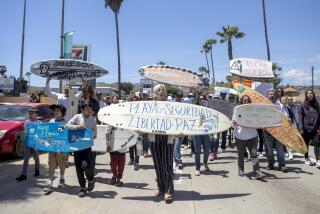U.S. Ties 5 to Afghan Camp
The capture of fugitive Ramzi Binalshibh last week in Pakistan gives investigators their first opportunity to fully understand the inner workings of the Sept. 11 attacks on the United States. A frustrating yearlong investigation that had been successful only on the fringes suddenly has the potential to penetrate to the center of the plot, according to U.S. and German officials.
“You can’t overstate the importance of capturing Binalshibh,” said one U.S. Justice Department official.
Even before the capture, German Federal Prosecutor Kay Nehm called Binalshibh “the essential person” in the plot. Investigators believe that Binalshibh was a key conduit for both money and information between the hijacking teams in the United States and the Al Qaeda command in Afghanistan.
Whether Binalshibh will cooperate with investigators is not known, but he wasn’t hesitant about proclaiming his role--and pride--in the attacks in an interview he reportedly granted to the Arab satellite television network Al Jazeera early this summer. In that interview, broadcast last week, a man claiming to be Binalshibh described himself as a coordinator of what he referred to as the “Holy Tuesday” attacks.
German officials are comparing audiotape of the broadcast with tapes they had previously obtained of Binalshibh speaking at a wedding celebration in Hamburg. Binalshibh is under indictment in Germany as a conspirator in the deaths of more than 3,000 people. If the voices match, the Al Jazeera tape will provide an ad hoc confession.
More urgently, in addition to crucial details of Sept. 11 planning, officials hope that Binalshibh can provide information on current Al Qaeda operations. He was accompanied at the Al Jazeera interview by Khalid Shaikh Mohammed, who many investigators think was the initiator of the Sept. 11 attacks and who has since risen to the top tier of the Al Qaeda hierarchy. Mohammed described himself in the Al Jazeera interview as head of Al Qaeda’s military department, so he would presumably have full knowledge of current Al Qaeda plans, some of which Binalshibh might also possess.
The Al Jazeera interview apparently took place in Karachi, Pakistan, in June. It was in Karachi on Wednesday that Binalshibh was captured before a fierce gun battle that left two men dead. Pakistani officials said it was only by luck that Binalshibh was not one of those killed.
Mohammed has been sought by U.S. law enforcement since Philippine police foiled a 1995 plan to blow up a dozen American airliners over the Pacific. The Filipinos believe that the idea to use airliners as bombs was Mohammed’s, and he apparently carried it forward to its eventual fruition last September. Other captured Al Qaeda officials have told investigators that Mohammed brought the idea to Al Qaeda’s leadership.
Mohammed told Al Jazeera that a decision was made in 1999 to mount an operation against the United States. Late that year, Binalshibh and the three men from Hamburg who piloted the hijacked Sept. 11 jets visited an Al Qaeda camp outside Kandahar, Afghanistan. Investigators believe that it was at that meeting that the Hamburg men agreed to take part in a suicide attack against the United States.
Shortly after the meeting, Binalshibh traveled to Kuala Lumpur, Malaysia, where, according to investigators, he met with other future hijackers from Saudi Arabia and the man suspected of coordinating the October 2000 attack on the U.S. destroyer Cole in Yemen. German investigators say Binalshibh was in Yemen at the time of the Cole attack, just as he seems to have been present nearly every step of the way leading to Sept. 11.
He appears in the investigative record so frequently that some German investigators now think that Binalshibh, not Mohamed Atta, could have been the moving force behind the formation of the Hamburg cell. Among other things, the investigators note that Binalshibh’s photograph was found among the belongings of several dead or captured Al Qaeda fighters, as if he were a sort of revered figure.
Binalshibh was born in a remote mountain region of Yemen in 1972. He is reported to have worked in the administrative section of the International Bank of Yemen in Sana, the capital, before arriving surreptitiously in Germany in 1995. Investigators are unsure of the precise date of his arrival. The first known record of him in Germany was his September 1995 application for political asylum under the name Ramzi Mohamed Abdellah Omar. He claimed in that application to be a university student fleeing persecution in Sudan. While his application was reviewed, Binalshibh was assigned to live in a camp for asylum seekers, in the small town of Kummerfeld, just north of Hamburg.
In the camp, occupants lived in a crowded, makeshift building that authorities referred to as a container. Those in the container complained constantly about their living conditions, but Binalshibh remained in the background, officials say. Officials acknowledge that the containers became home to a variety of illegal activity, including document fraud and drug trafficking.
“It would be easy to come here and build up an organization,” said Michael Hirsekorn, chief administrator of the camp. It was while living in Kummerfeld that Binalshibh apparently met Atta, an Egyptian graduate student. A former roommate of Atta’s told The Times that he recalled seeing Binalshibh at Atta’s residence as early as 1995.
Binalshibh’s asylum application was denied in 1996, and he appealed. While the appeal--which was eventually denied--was waiting to be heard, he returned to Yemen and, using his real name, received a student visa to Germany and came back.
The subterfuge about his identity has led some investigators to believe that Binalshibh was already an Al Qaeda agent when he first came to Hamburg.
Binalshibh became active in Hamburg’s fundamentalist mosques. The head of one mosque said Binalshibh often helped others interpret the Koran, the sacred text of Islam.
During his six years in Hamburg, Binalshibh apparently never had regular employment and did not regularly attend school. He enrolled in at least two college language courses but attended rarely or not at all.
He, Atta and a third man, Said Bahaji, became roommates in late 1998, sharing an apartment near the university Atta and Bahaji attended. Bahaji and another Hamburg man, Zakariya Essabar, have been indicted by the Germans on charges similar to those faced by Binalshibh and remain at large.
After members of the Hamburg group went to the Al Qaeda camp in late 1999, they began making preparations to go to the United States, applying to flight schools and seeking U.S. visas. Binalshibh applied once to a flight school and for visas four times unsuccessfully. U.S. officials have said he was denied entry not because he was a suspected terrorist but because Yemen is a poor country and Yemenis were viewed as potential economic migrants.
After his failure to gain entry into the U.S., Binalshibh became a sort of clearinghouse for the hijackers, investigators say. He funneled money to the terrorist teams. He met with Atta at least twice and with another of the hijacker pilots at least once. He traveled widely, visiting the Netherlands, Iran, Afghanistan, Spain, Yemen and Malaysia.
He also traveled to London, where investigators think that he met with Zacarias Moussaoui, the only man in custody in the U.S. who is charged with a direct connection to the Sept. 11 attacks. The U.S. indictment of Moussaoui sets out the theory that Binalshibh recruited him to take Binalshibh’s place among the hijackers.
Moussaoui faces a possible death penalty if convicted, and his fate may now rest with whatever Binalshibh tells interrogators. Germans have resisted assisting in the Moussaoui investigation because of their opposition to the death penalty. The same conflict could also arise in the case of Binalshibh.
German officials said Saturday that they want Binalshibh extradited to face criminal charges in Germany. If that happens, it will be almost impossible for U.S. authorities seeking the death penalty to bring Binalshibh to the United States for trial.
Binalshibh is being held by Pakistan’s Inter-Services Intelligence agency.
*
Times staff writer McDermott reported from Los Angeles and special correspondent Laabs from Hamburg. Staff writer Josh Meyer in Washington contributed to this report.
More to Read
Start your day right
Sign up for Essential California for news, features and recommendations from the L.A. Times and beyond in your inbox six days a week.
You may occasionally receive promotional content from the Los Angeles Times.






